In 1925, Alfred L. Kroeber — a once-venerated anthropologist and professor at University of California, Berkeley — declared the Ohlone people of the East Bay to be “extinct for all practical purposes.” Kroeber’s inaccurate assessment contributed to the loss of federal recognition for the tribe. Millions of acres of land were ripped from the Ohlone people, an act that ended up being a contemporary continuation of the genocide and land theft they’d faced from Spaniards and Americans for two centuries.
Declaring a people extinct does not make it so, but it does push them further to the margins, forces them to disperse, and threatens their ongoing survival. Despite this, the Ohlone — and their food traditions — have survived. On UC Berkeley’s campus, the same institution that declared the group extinct, the world’s only restaurant owned and operated by Ohlone people, serving their traditional food, thrives.
Business and life partners Vincent Medina (Chochenyo Ohlone from the East Bay) and Louis Trevino (Rumsen Ohlone from the Carmel Valley) founded mak-’amham (“Our food”) in 2017 to promote cultural awareness, and began Cafe Ohlone in 2018 as a vehicle for that work. Together, they present what they call a “love song” to Ohlone culture.
“We want people to walk away from every meal understanding our community much more than they did when they first came in. There’s so much ignorance, some of it willful. But we want to lift up the knowledge that’s been passed down from our elders and our community,” Trevino says. He grew up with a deep understanding of his roots, passed down from his grandparents, who are now both in their late 80s. And despite the apocalyptic levels of gentrification in the Bay Area, Medina’s family has never moved away, although this was an incredibly difficult feat. “That’s a testament to the love and the sacrifice of those generations before us that they always maintained our place in our homeland,” he says.
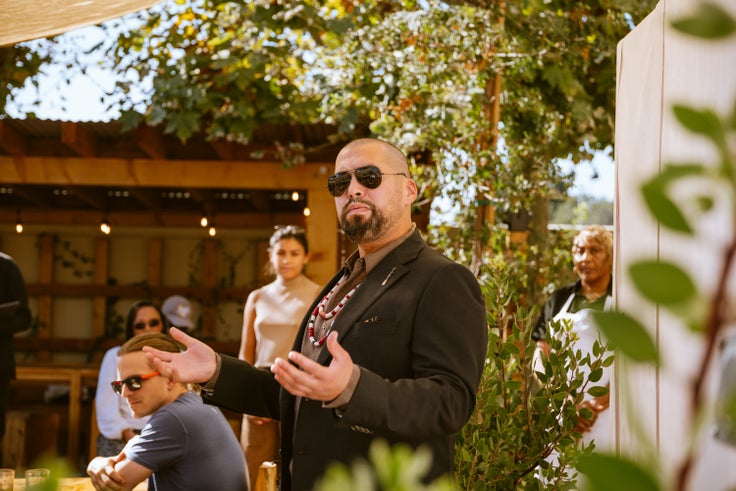
One afternoon in late summer, I went to Cafe Ohlone for lunch and sat next to Ann Speyer, a white woman who volunteered with the restaurant during its early years. I commented to Speyer that the food was so fresh that I could eat plates of it and never feel heavy. Her response resonated. She said that for one of the few times in our lives, we were in “right relationship” to our plates. It does feel like a rare spiritual experience in the age of climate catastrophe, when your ethics and beliefs can match what you eat. And when Medina declares ’ammamak (“Let’s eat!”), the meal diners are presented with is infused with a sacred specificity.
My lunch that day was composed of the Indigenous food of late summer in the East Bay. Kahha maarah, a salad filled with Indigenous ingredients like gooseberries, popped amaranth seeds, California bay laurel coulis, and pickleweed — a succulent that grows on the salt marshes, its brackish bursts of flavor adding definition to the salad.

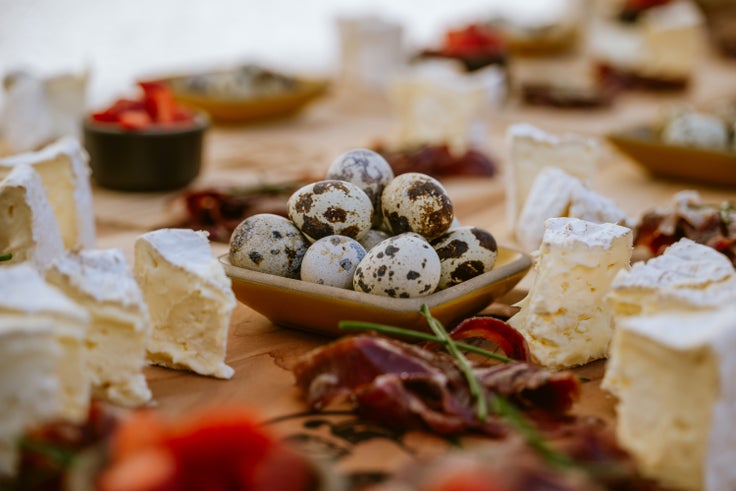
We were also served rose hip tea, historically used by the Ohlone to soothe the respiratory system during fire season. There were soft-boiled quail eggs, their shells peeling like green-brown confetti on our plates and a small dish of Bay salt to dip the eggs in; heirloom potatoes roasted in duck fat; smoked rainbow trout; and pattih, a chia seed (chia are a traditional Ohlone food) porridge with huckleberries and wet-roasted hazelnuts. Here, because the community and connection is centered, diners can ask for second or third portions without hesitation and without charge.
Prior to the opening of its Berkeley location, Cafe Ohlone was a pop-up in the backyard of the now-closed University Press Books. During the early stages of the COVID-19 pandemic, Medina and Trevino delivered meals, something Filipina German scholar Karin Hermes pointed out was especially meaningful “as infectious diseases brought by colonial settlers are also a central memory of Native American health and histories.” The socially distanced meals were reminiscent of traditional, centuries-old acts of preservation and care.
This current iteration of Cafe Ohlone at UC Berkeley, surrounded by a garden of plants native to the region with tables of reclaimed redwood and abalone shells scattered in the plant beds, is called ’ottoy, which in Chochenyo, one of the Ohlone languages, means “repair.” Although everyone refers to it as Cafe Ohlone, the restaurant’s official name is ’ottoy.
This theme of repair is especially poignant at this location, not just because of Kroeber’s claim that Ohlone were extinct, but because anthropologists from UC Berkeley have dug up cemeteries of Indigenous people for scientific research.
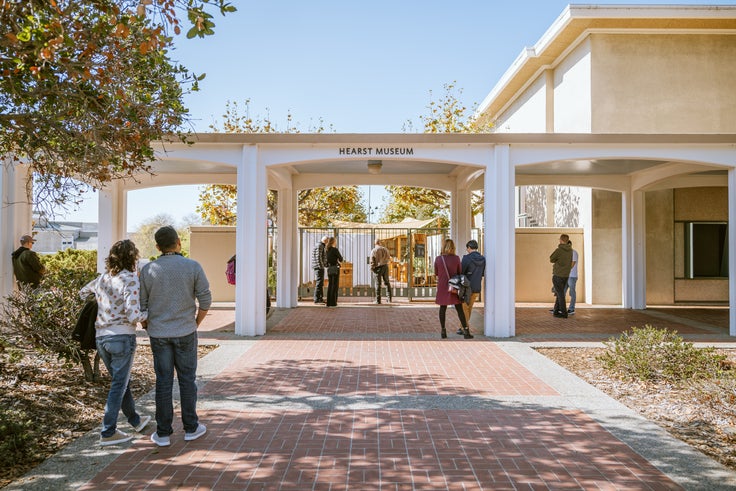
Medina, who also sits on the Native American Graves Protection and Repatriation Act Implementation Committee at UC Berkeley says, “We’ve known these things in our community, but they weren’t talked about by the university. They were talking about their own achievements while leaving us out, while leaving the true story out.”
There is currently a repatriation effort led by Indigenous people working with the university and the state of California, Medina says, to ensure that “tribes can see their ancestors brought home for proper burial” and can also see cultural inheritance like baskets and other art brought back from the anthropology department. Kroeber interred a Yahi Native American man they called “Ishi,” which means “man” in Yana (his true name is unknown because Yahi custom dictated that he not speak it himself) in the department of anthropology for the last four years of his life, turning a human into a living museum and spectacle.
’Ottoy is an ongoing effort at UC Berkeley’s department of anthropology — which has a building that remains unnamed after the school stripped Kroeber’s name from it in 2021 — where full restitution has yet to be completed. But with Cafe Ohlone’s intimate lunch and brunch experiences (it plans to expand to include dinner sometime in November) diners begin to see the reparative power of food.
Some Indigenous restaurants, like Minneapolis’ Owamni, exercise the discipline of using only ingredients that existed on this continent prior to colonization. Medina and Trevino have a similar approach, but one that contains adaptations made during colonial times. Both techniques honor that North American Indigenous food is a living, dynamic force that has never stopped evolving. But the latter approach has more direct nods to the colonization that forced it to evolve.
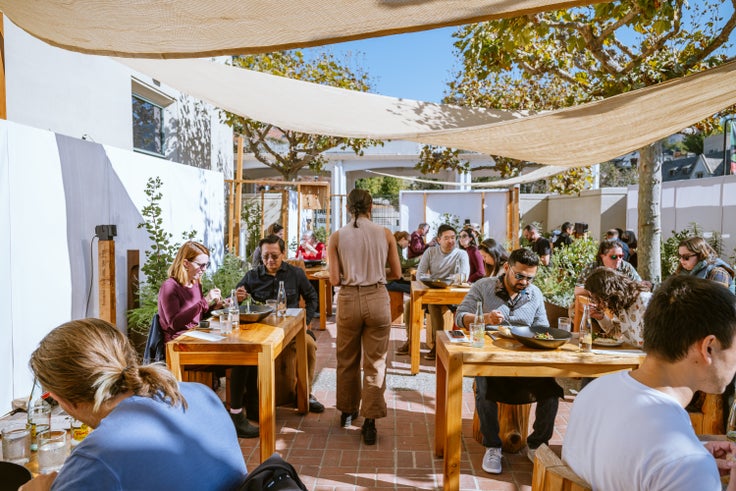
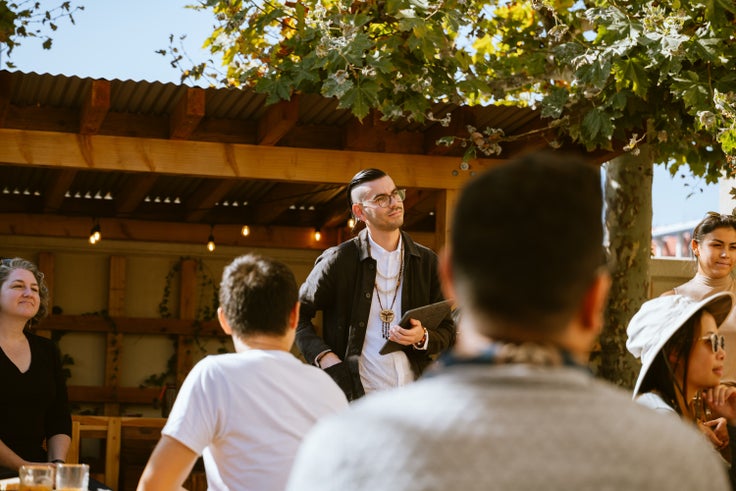
The “mission period” in California, lasting from 1769 until about 1833, with 21 missions in total, was an effort by Spanish colonists to expand their control over the land, culturally decimate Indigenous people through forced conversions to Catholicism, and separate Indigenous children from their families and extract slave labor. The mission period looms large in almost every Indigenous family’s story from California, including those of Medina and Trevino. Trevino’s family is Rumsen Ohlone, from Carmel Valley, and during the mission period they were “displaced and had to travel in order to stay safe.” That’s how Medina’s family, which is Chochenyo Ohlone, and Trevino’s family met, when they lived in Sunol. “It was a somewhat isolated part of the East Bay where Indian society could flourish in a safe way,” Trevino says.
The missions also influenced their cuisine, and the menu at Cafe Ohlone, where they sometimes serve their 92-year-old elder Aunt Dottie’s tamales. Medina says her recipe is specific to California and came from the missions.
“Our family made them in the same shape that our traditional Ohlone acorn bread is made. But they’re made with meat that’s not native to California and with corn flour, two ingredients that are from the mission times,” Medina explains.
“As a kid, I always had my hand in the tamale pot. It brings up so many family memories. We don’t want to leave out those recipes just because they aren’t strictly made with California native ingredients. They still have a place in our history. They still follow a direct trajectory,” Medina says.
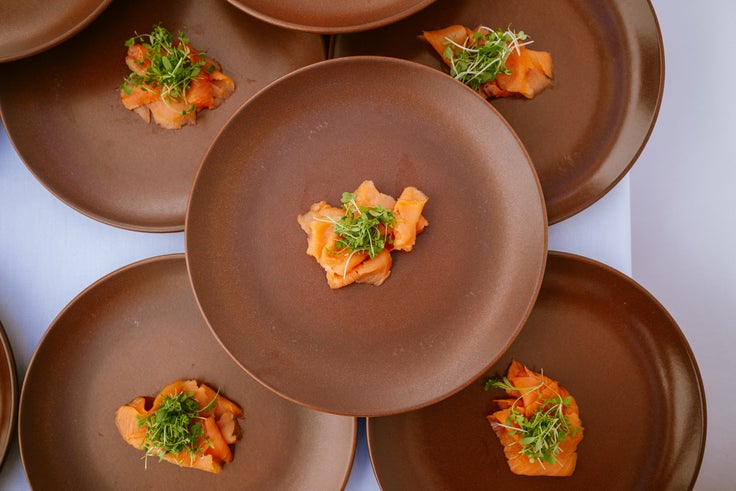
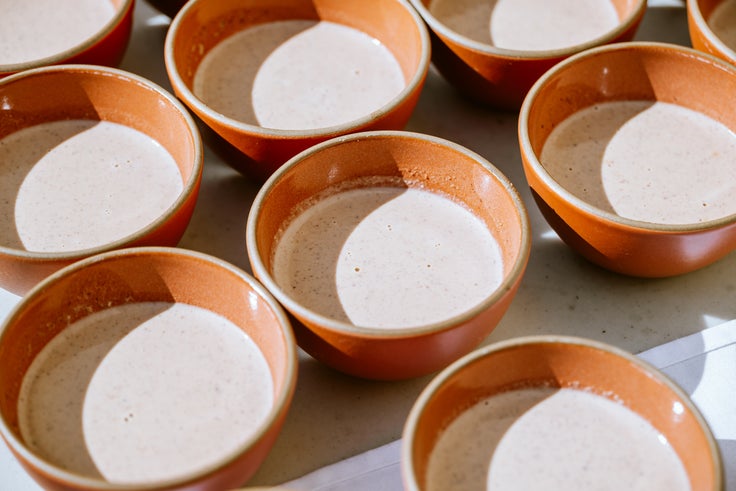
But at the forefront of Cafe Ohlone will always be traditional ingredients, restoring the community’s relationship to their plates, the thread that links the soul of the land to the soul of the people. “There were times in our family when these foods weren’t available, for very deliberate reasons. When Americans came in, they banned the controlled burns, to try to separate California Indian people from our traditional food stewardship practices,” Medina says. “That’s our way of producing food in large amounts because it enriches the soil, clearing out overgrowth so that the foods and interconnected plant communities grow stronger.”
Medina and Trevino also, with the leadership of Ohlone elders, hold Chochenyo language classes for Ohlone people of all ages. Medina is inspired in this effort by his great-grandmother Mary Archuleta, who wove baskets, spoke Chochenyo and taught him about the land.
One student, a 10-year-old girl named Amaya Ruano, has reached fluency. “She can string together big concepts in Chochenyo,” Medina says. “She can have a conversation with her relatives. She can joke. It’s really sweet. She also started to teach her friends because she said that it was something that made her feel pride. Something that makes her distinct.”
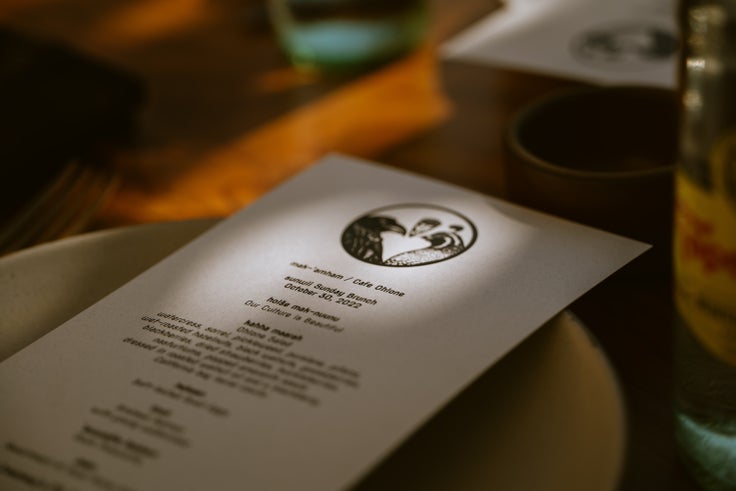
When Kroeber declared the Ohlone people extinct in 1925, he abetted the theft of their land. But despite the institutional power he wielded, he never had the power to extinguish the love Ohlone people had for their culture and for each other. Nearly a century after his haughty and false claim, in the same courtyard of the building where he committed grave violations against California’s Indigenous peoples, Cafe Ohlone stands strong, bolstered by Medina, Trevino, and the chorus of community that supports them.
In Ohlone culture, ṭuuštak or Mount Diablo — a mountain peak an hour’s drive from Cafe Ohlone — is the creation place. “There was a great flood and the waters descended from the mountain, and created the world, and then its people,” Medina tells me. “So, we’re right where we’ve always been. Even though prices are rising, gentrification, constant development … this will always be Ohlone land.”

